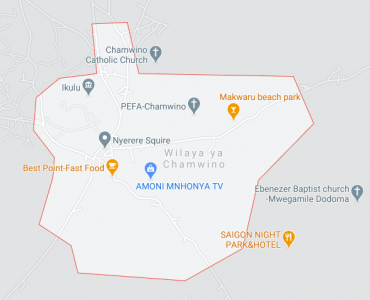The district has Savannah type of climate which is characterized by low and unreliablerainfall (400 mm), short rain season (December to April), long dry season (April toDecember), persistent desiccating winds and low humidity. Atmospheric temperatureranges from 21°C to 23°C. In such type of climatic condition, whereby crop productiondoes not perform well, livestock production becomes the solution to food security andother economic constraints in the family level. The main economic activities are cropfarming and livestock keeping.
Livestock Population
There are several breeds of animals kept by livestock keepers in the District. Accordingto 2002 livestock census projections, the population of livestock in the District is asfollows:
Cattle 299,166, Goats 51,435, Sheep 12,709, Pigs 3,642, Chicken 351,067, Dogs 4310.For the past few years there has been a significant increase in the number of livestock inthe district, partly due to migration of agro- pastoralists into the District. High populationof animals is found in Makang'wa ,Chilonwa .Itiso and Mpwayungu divisions.
The Department of Livestock and Fisheries
The Department is led by Head of Department (District Livestock and Fisheries Officer).Below him at the District headquarter there are 7 Sections and Subject matter specialistsin ; Animal Health, Meat production hide and skin, Range Management, Small stock,Livestock extension, Zoo-sanitary and livestock identification and traceability. We havequalified stuff at headquarter holding relevant Master degrees and first degrees in thefields of livestock production, Veterinary medicine/Science and Fisheries. Also we havewell experienced diploma holders.
At ward level we have qualified extension workers holding first degree and diplomas.There are 32 wards but few wards have got no extension workers.At village level the stuffing situation is not so good. There are 78 villages but only 32villages have got extension workers.
Livestock Infrastructures
We have a good number of livestock infrastructures in the District. Some of theseinfrastructures are not operating. Some infrastructures are out of order and they needrehabilitation. The following are livestock infrastructures that can be found in ChamwinoDistrict: Twenty seven ditanks, 12 charcodams, 25 water troughs, 14 livestock markets, 4veterinary centres, 4 hide/skin drying sheds and 13 slaughter slabs.
The Department Responsibilities
The main Responsibilities of the Department of Livestock and Fisheries are as follows;
Marketing
The District has fourteen (14) livestock primary markets where live animals are sold.Livestock traders buy animals from these markets and transport live animals to otherDistricts and Regions. The biggest market for our animals is a secondary market situatedat Pugu Dar-es-salam.In order to secure high price of our commodities, we add value to our products along the"food production chain".Livestock farmers and traders have been trained to process hides and skins by usingmodern practices (Salting), tannings hides/skin and make leather products such ashandbags, belts, shoes etc. Livestock farmers fetch good price by selling leatherproducts.
We have established a cattle fattening unit at Mpwayungu Village. The unit is still underconstruction. In this unit cattle will be provided with supplement feed and receive extrahealth care for 3 months. We expect the animals to gain 20% to 30% of their bodyweight i.e. increase in quantity and quality of meat hence fetching high price of meat.Success
The breeds of our animals i.e. cattle, goats and chicken have been improved throughartificial insemination and natural breeding.Introduction of exotic breeds has increased the quantity and quality of livestock products.Leather products such as handbags, shoes are manufactured by livestock farmers.Good number of livestock farmers has knowledge on "good livestock farming practice"Good participation of farmers in Agriculture shows has made chamwino District to winthe first prize for four consecutive years.
Challenges
The Way Forward

Halmashauri ya Wilaya ya Chamwino
Sanduku la posta: 1126 Dodoma
Simu ya Mezani: 026 296 1511
Simu ya Mkononi:
Barua Pepe: ded@chamwinodc.go.tz
Hakimiliki©2017 Halmashauri ya Wilaya ya Chamwino. Haki zote Zimehifadhiwa.